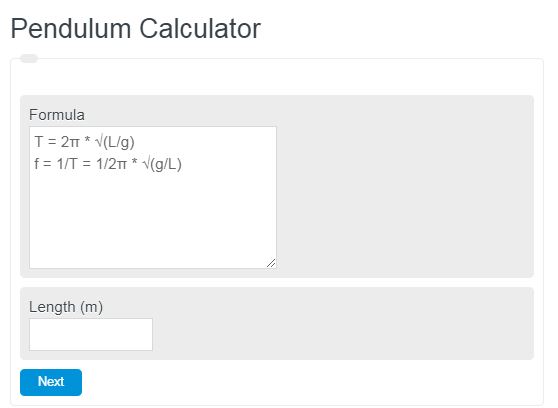Enter the acceleration due to gravity and the length of a pendulum to calculate the pendulum period and frequency. On Earth, the acceleration due to gravity is always approximately 9.81 m/s^2.
- Frequency Calculator
- Acceleration Calculator
- Gravitational Potential Energy Calculator
- Natural Frequency Calculator
- Pendulum Force Calculator
Pendulum Calculator
The following two formulas are used to calculate the period and frequency of a simple pendulum. In this case, a simple pendulum is described as having no other external forces acting on it. This includes air resistance.
T = 2π * √(L/g)
- Where T is the period (seconds)
- L is the length
- g is the acceleration due to gravity
f = 1/T = 1/2π * √(g/L)
- Where f is the frequency
- L and g are length and acceleration as before
Pendulum Definition
A pendulum is any weight suspended from a pivot that swings freely under no additional forces other than gravity.
How to calculate the pendulum period?
How to calculate a pendulum period?
- 1. First, determine the length. Measure the length from the center of the mass to the pivot point.
- 2. Next, determine the acceleration due to gravity. On Earth, the acceleration is 9.8 m/s^2.
- 3.Finally, calculate the pendulum swing period. Using the formula above, determine the time period.
FAQ
What factors can affect the accuracy of a pendulum's period and frequency calculation?
Several factors can affect the accuracy of a pendulum's period and frequency calculation, including air resistance, the mass of the pendulum bob, the rigidity of the pendulum's string or rod, and any external forces acting on the pendulum. Precise measurements and controlled conditions are necessary for accurate calculations.
Can the pendulum formula be used on other planets?
Yes, the pendulum formula can be used on other planets, but the acceleration due to gravity (g) must be adjusted according to the planet's gravity. Each planet has a different value of g, which significantly influences the pendulum's period and frequency.
How does the length of the pendulum affect its period?
The length of the pendulum directly affects its period; the longer the pendulum, the longer the period. This relationship is due to the formula T = 2π * √(L/g), where T is the period, L is the length, and g is the acceleration due to gravity. As the length increases, the square root of the length increases, thereby increasing the period.

